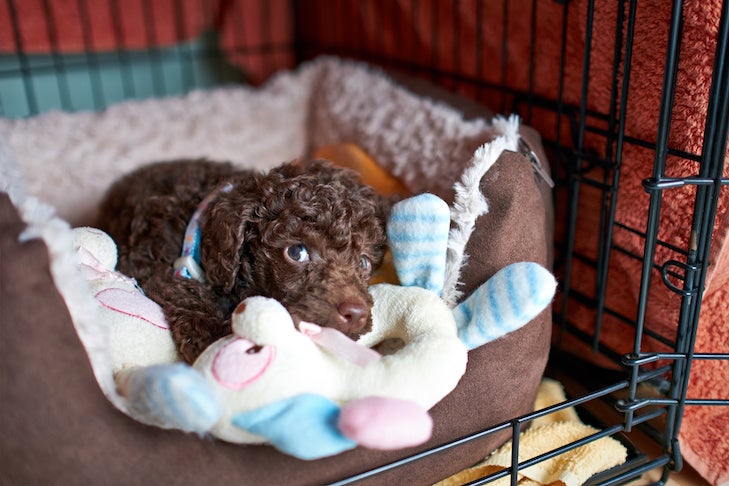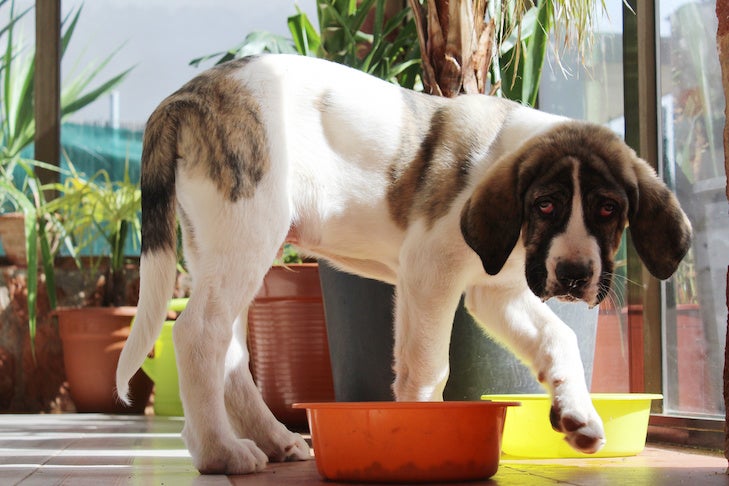
AKC is a participant in affiliate advertising programs designed to provide a means for sites to earn advertising fees by advertising and linking to akc.org. If you purchase a product through this article, we may receive a portion of the sale.
Many owners use a dog crate to help potty train their puppy. Crates can be extremely helpful in house-training dogs, but some puppies soil their crates – the very problem you’re trying to avoid by using the crate in the first place. What do you do if your puppy’s regularly peeing or pooping in their crate?
Why Is My Puppy Soiling Their Crate?
The first consideration is how often this happens. A few accidents when your puppy’s been in the crate for too long may not be a cause for concern. After all, most puppies sometimes get upset stomachs, which can result in crate soiling.
Unless the dog is making it a frequent habit to pee or poop in the crate, there’s no cause for concern. But if eliminating in the crate is becoming a habit, you can take steps to figure out why this is happening, as well as ways to prevent it.
How to Deal With Puppies Going Potty in Crates
Consider Taking Your Dog to the Vet
Bringing your dog to the vet for a check-up is a great idea to rule out any underlying medical conditions. The vet can make sure your puppy doesn’t have a urinary tract infection or any other type of illness that could physically prevent them from holding their bladder for an adequate period of time. A medication your puppy is taking or a vaccine they’ve received may also be causing this side effect.

Keep an Eye on What They Eat
Watch what your puppy eats off the ground when you’re outside. Eating something that upsets their stomach could result in doggie diarrhea or loose stools, and you may see a puppy pooping in crates.
Talk to your vet about whether your puppy’s food or treats could be irritating their stomach.
Listen to Your Puppy
If the problem is happening at night, it may be that your puppy and their bladder haven’t developed enough to hold it all night long. Many young puppies will need to be carried outside quietly once during the night until they are several months old. Keep an ear open at night so you can hear if your dog is indicating they need to go out.
Make Sure Your Dog’s Been Introduced Properly to the Crate
Your puppy should see their crate as a quiet refuge or den, rather than a space that causes them anxiety. If they’re unsure about the crate, build up positive associations with the crate. During the day, give them their puppy food, puppy chew toy, or puppy toy stuffed with a spreadable treat while they’re in the crate. When your dog goes into the crate willingly, give them a puppy treat.
Keep Track of Time
There’s a general rule of thumb for calculating long your puppy can “hold it” before needing to go outside. You add the number of months in age they are, plus one, and get the number of hours possible. So if your puppy is 3 months old, they should be able to go about four hours before needing to go outside.
Before you put the puppy in the crate, take them outside and watch to see that they do their business every time. If they’re still peeing in the crate, they may need more frequent potty breaks, whether with you or a dog walker.
Set a Feeding Schedule
Keep your puppy’s meals on a regular schedule. This will give you an idea of when the puppy will need to go out. Young puppies eat three times a day. What goes in on a regular schedule will come out on a regular schedule. For example, if you feed your puppy at 8 a.m., noon, and 5 p.m., their elimination schedule should become pretty predictable. This may prevent puppy pooping in crates.

Limit Space in the Crate
Your puppy’s crate should be just big enough for them to turn around and lie down. Many crates have dividers to keep the space small until your dog starts to grow – and then you can remove it.
Dogs are naturally clean and don’t like to soil where they sleep. So you don’t want the crate to be so big that the puppy chooses one side as the bathroom area. Use a separate dog pen, rather than the crate, to contain your puppy for longer periods of time.
Take Bedding Out of the Crate
If you follow the above steps and your dog is still soiling their crate, consider removing the puppy’s bedding. Some dogs learn that they can soil the crate and cover the mess with their bedding, while some puppies prefer to pee or poop on something soft, like their bed.
Removing the bedding for a short time can teach your dog that it’s in their best interest not to soil the crate, since they won’t want to lie in their pee or poop.
If You Find an Accident, Carry Them Outside
If you do find an accident in the crate, carry the puppy outside to their potty spot. Next, clean up the crate with a dog-safe cleaning product that will neutralize the odor, and wash the bedding.
Many puppies may have an occasional accident in the crate for a number of reasons, but if the behavior becomes frequent, talk to your veterinarian. You may also want to consult an animal behaviorist.
In the meantime, stay calm and be patient. Since dogs can sense people’s stress, we don’t want to accidentally make the puppy more anxious. This may make the problem worse.

